Jim ‘Slim’ Mimlitz, SCADAmetrics
For an automobile, everyone is familiar with Miles-Per-Gallon or MPG. Today, we are going to introduce an equivalent measure of pump station efficiency that every water utility Telemetry/SCADA system should include: GPK.
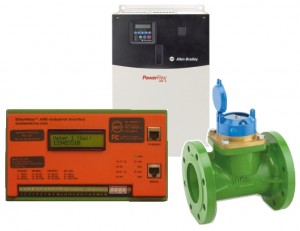
Using the EtherMeter, a VFD (Variable Frequency Drive), and a Flow Meter to Optimize Pump Station Energy Efficiency.
Automobile Efficiency…
Have you ever calculated the average gas mileage for your automobile? It’s fairly simple ― At two successive fuel tank fill-ups, check the odometer, and calculate the difference in miles: Delta-Miles. Then, after the last fill-up, note the amount of fuel added: Delta-Gallons.
MPG (Miles per Gallon) = Delta-Miles / Delta-Gallons
Note that the above measurement provides an average MPG achieved throughout the previous tank of fuel.
It is also useful to know the realtime MPG, but this requires knowledge of the instantaneous automobile speed and the instantaneous fuel flow-rate:
MPG (realtime) = Speed (MPH) / FuelRate (Gallons/Hour)
Some late-model automobiles, assisted by an internal computer and sensors, provide a visual display of realtime MPG on the dashboard:
Pump Station Efficiency…
Equivalently, in a water utility, it is also possible to calculate the energy efficiency for your water pumping system:
GPK (Gallons per KilowattHour) = GallonsPumped / KilowattHours
Note that the above measurement provides an average GPK achieved throughout some fixed time period.
As with the automobile example, it is also useful to know the realtime GPK, but this requires knowledge of the instantaneous Pump FlowRate (Gallons per Hour) and instantaneous Power (KW):
GPK (realtime) = 60 x FlowRate(GPM) / Kilowatts
If the pump station contains: (1) Flow Meter, (2) SCADAmetrics EtherMeter®, and (3) A Full-Featured Variable Frequency Drive with Modbus ― then it is equipped with everything necessary to measure and trend realtime GPK:
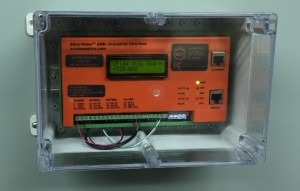
EtherMeter: Connects Neptune HP Turbine Meter to Station Control System via Modbus/RTU (via RS-485 twisted pair).
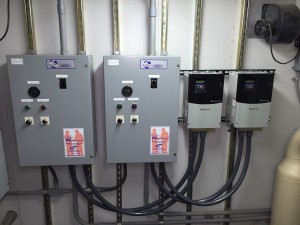
Allen Bradley PowerFlex VFD’s – Connected to Station Control System via Modbus/RTU (via RS-485 twisted pair).
The EtherMeter provides the GallonsPumped and FlowRate figures via Modbus:
40001-40002: Totalization (Gallons) 40005-40006: Rate-of-Flow (GPM)
A unique feature of the Allen Bradley PowerFlex® VFD is its ability to transmit Kilowatt and Kilowatt-Hour figures via Modbus/RTU:
40011: Output Power (KW) 40012: Elapsed Energy (MWH) 40016: Elapsed Energy (KWH)
Therefore, a connected PLC or SCADA system can collect these measurements ― using Modbus, DF1, or EtherNet/IP™ ― to provide a running display of Pump Energy Efficiency.
Why is this measurement important? Because when pump speed ― and therefore flow rate ― is reduced and optimized by controlling a VFD’s output frequency, pipeline friction losses are reduced. And since friction losses are proportional to the flow-rate squared, reducing the flow-rate by even a modest factor may yield significant energy savings. In an extreme example, reducing flow-rate by a factor of 2 will reduce pipeline friction losses (wasted energy) by a factor of 4.
In a successful real-world application, we recently observed a Water Utility who was able to reduce its average pump energy consumption by a factor of 3! In this project, the customer replaced soft-starters with VFD’s and leveraged a Flow Meter/EtherMeter combination to optimize the rate-of-flow and GPK. Before the introduction of the VFD’s, the pumps were only capable of running at 100% speed ― typically pumping at a flow rate of 352.3 GPM ― with an average efficiency figure of 1328 GPK.
After the VFD’s were installed and optimization completed, a new average rate-of-flow was set at approximately 169.34 GPM ― yielding a new average efficiency figure of 4033 GPK. At the time of this writing, the cost per a Kilowatt-Hour is generally around $0.12, so the pump station’s energy costs were calculated to drop from $345/month to $114/month!

Pump “Gallonage” (GPK) – 24 Hour History Chart (above). Note that the GPK can spike up during pump ramp-up and ramp-down — This is normal.
Also, Rockwell Automation offers a useful tool in the form of an online energy savings calculator.
Are you interested in learning more about how the SCADAmetrics EtherMeter can be combined with the Rockwell PowerFlex VFD within a Modbus or DF1 or EtherNet/IP™ network to enhance your SCADA/Telemetry system? Give us a call, and we’ll be glad to help you achieve the most out of your pump energy dollar, ever in accordance with our motto:
“You can’t manage what you don’t measure.”



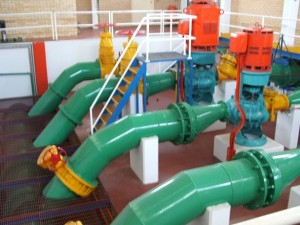
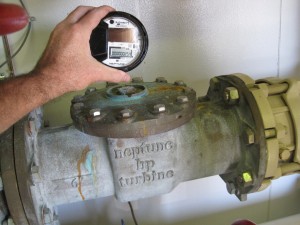

Thanks for the article. We didn’t examine pump station’s efficiency from this view yet. Very interesting!